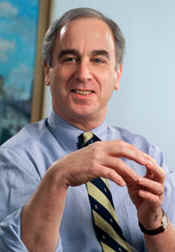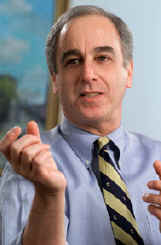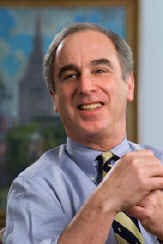-
"Trinity will be a benchmark school!"
An interview with President Richard H. Hersh
-
By Michael Bradley '98
 What attracted you to
Trinity College?
What attracted you to
Trinity College?I knew a great deal about Trinity before I came here because it is a school you hear many good things about when you’re a college president. It has an exceptional reputation and a great faculty. I also learned about the College in greater detail when I was a consultant to the Learning Corridor project. So I know about Trinity both from a distance by its reputation and with a much more in-depth understanding because of my involvement with the work the College has done here in Hartford.
Tell us about your background. How will you use this experience in your work here?
I started out as an engineering student at Syracuse University. I went there because they had a special five-year program that gave you both an engineering degree and a liberal arts degree. Right from the start, I had been taught to believe in the importance of a liberal arts education.
The fact that I’ve been an administrator at big research universities like Harvard and the University of Oregon gives me an appreciation of the research and scholarship side of the academy. But I left those larger schools when I felt I had drifted too far away from working directly with students. I moved from Oregon to the University of New Hampshire, which was smaller, then from New Hampshire to Drake, a private institution and smaller still, and finally from Drake to Hobart and William Smith Colleges, where working with the faculty and students was the essence of my job. So my background started out with a liberal arts orientation and has gone full circle from big universities to small liberal arts colleges.
Having had leadership experience in a variety of settings, I see an opportunity at Trinity to accomplish those things that ideally should be done at small liberal arts colleges. Such colleges have the advantage of being able to offer small classes that are not taught by graduate assistants, as is often the case at larger schools, but by professors who demand a great deal of reading and writing from students, meet with them outside of class time, and give very close advising. Small liberal arts colleges also afford the unique opportunity to construct a genuine community in which intellectual life is pervasive, diversity is celebrated in authentic ways, and each student really does have the opportunity to find his or her own voice. Trinity already has the essential ingredients—an excellent reputation, a first-rate faculty, and exceptional students.
 What is your vision for the
future of Trinity?
What is your vision for the
future of Trinity?I don’t come in with a fixed vision, but I do come with certain biases. One of them is that I want to be part of the best institution of its kind in the nation. For me, it’s about creating the most powerful educational institution, where students really do gain all the things we make promises about in college catalogs. The reason we’re here, in my view, is to create a college that everybody in the country recognizes as a point of reference.
Trinity will be a benchmark school. When people think of the best possible liberal arts education in America, the first name that should come into their heads is Trinity. Many of the attributes that make a school special exist here already—diversity, the tutorial college, international studies programs, independent study, and making extensive and appropriate use of the city. The challenge is to use these strengths to create a distinctive and distinguished identity for the College. The Trinity vision is still to be constructed, but the criteria for excellence in that regard are well known.
You have collected survey data suggesting that college-bound high school students and their parents may have a less favorable perception of liberal arts education than the nation’s leading CEOs. Does this apparent disparity point to misconceptions about the liberal arts that Trinity must address in order to attract the nation’s best students?
I did a national study with Daniel Yankelovich, the noted public opinion pollster, who was on the Brown University board of trustees and who is a social scientist of the highest order. We asked high school students who were about to go to college, their parents, teachers, principals, CEOs of Fortune 500 companies and their personnel directors, university professors, liberal arts college professors, liberal arts college graduates, and university graduates what they understood to be the nature, purpose, and value of a liberal arts education in general and at small liberal arts colleges in particular.
We found that parents, high school students, and high school teachers generally had little understanding of liberal arts education. Professors who teach at big universities had a better understanding, but it was still rather poor. Happily, liberal arts college professors and liberal arts college graduates had a strong understanding of the value of liberal education. But the big surprise was that corporate CEOs also came out very strongly for—and understood more than most groups—the nature, purpose, and value of the liberal arts. They told us that the only way to increase productivity in this technological age is not with more machines or even computers but with smarter and wiser human beings! The CEOs said, “What we look for are graduates who can write, speak, think, and work well with other people and independently. But most importantly, we want people who can cross boundaries—across disciplines, cultures, and languages. We want people who can deal with diversity. Most of all, we want people who can continue learning, who can get a ‘practical education’ by being able to continually learn.” They were particularly articulate and very passionate about liberal education being the best “practical education” because it truly achieves these purposes.
How do you plan to further Trinity’s academic reputation?
 There are two strategies, external and internal, that
must be pursued simultaneously. The external strategy includes recruiting
the best possible students and faculty members, as well as understanding
things like the U.S. News & World Report rankings. Such rankings and
rating systems are incredibly superficial and often terribly wrong and
thus harmful, but they have come to symbolize the degree to which the
nation values excellence and academic reputation. Academic reputation as
measured by U. S. News, however, is the sum of opinions by presidents and
deans of faculty at other schools, and thus the way we communicate about
who we are to those people is very important.
There are two strategies, external and internal, that
must be pursued simultaneously. The external strategy includes recruiting
the best possible students and faculty members, as well as understanding
things like the U.S. News & World Report rankings. Such rankings and
rating systems are incredibly superficial and often terribly wrong and
thus harmful, but they have come to symbolize the degree to which the
nation values excellence and academic reputation. Academic reputation as
measured by U. S. News, however, is the sum of opinions by presidents and
deans of faculty at other schools, and thus the way we communicate about
who we are to those people is very important.Internally, and more importantly, the meaning of academic reputation is clear. It has to do with rigor, intellectual challenge, and student effort. Faculty and student cultures are crucial in this regard. The faculty is the conscience of quality on a campus, for it is faculty expectations and standards that largely determine the quality of teaching and learning. And the student peer group is also a powerful influence—it determines sleeping hours, eating habits, whether or not students feel good about their school, the amount and way in which students drink or don’t drink, and in part, how seriously students take their coursework. But how faculty members interact with students—the way in which they work with them in and out of class, the way in which they grade, the way in which they reinforce excellence, the way in which they celebrate intellectual achievement—ultimately determines academic reputation.
Finally, few campuses ever explicitly ask the question, “What do our students actually learn over four years because of our curriculum and teaching?” much less answer it with adequate assessment. Imagine if Trinity could demonstrate that we do make an important difference in our students’ lives! Such assessment would help us in our daily teaching and would allow us to better explain to prospective students and their parents that this is a campus willing to assess its own effectiveness.
What is your plan with respect to furthering multicultural programs and diversity at Trinity?
 The problem with “diversity” is that it has
turned into a pejorative word and is thought to be “politically
correct.” This is unfortunate because we know from research that the
most powerful catalyst for learning happens when you come into contact
with something that is new, anomalous, different, strange, or that
requires you to take a risk. This occurs with something you read or when
you see a piece of art or when you hear a lecture. It can happen if you
have a roommate different from yourself. It can happen when you encounter
people of a different race or people with a different language. It can
happen when you go into “diverse” neighborhoods or a “foreign”
country.
The problem with “diversity” is that it has
turned into a pejorative word and is thought to be “politically
correct.” This is unfortunate because we know from research that the
most powerful catalyst for learning happens when you come into contact
with something that is new, anomalous, different, strange, or that
requires you to take a risk. This occurs with something you read or when
you see a piece of art or when you hear a lecture. It can happen if you
have a roommate different from yourself. It can happen when you encounter
people of a different race or people with a different language. It can
happen when you go into “diverse” neighborhoods or a “foreign”
country.Diversity in all its forms catalyzes learning, and people who have truly become secure with themselves and others embrace diversity as a means for their own growth. This is why we should expose students to a curriculum and pedagogy where they experience a variety of ideas, ways of thinking, and knowledge. We need to expose students to a diverse array of faculty members and academic disciplines. Students ought to have extensive contact with students from different cultures, cities, races, socioeconomic backgrounds, ideologies, politics, and social classes, because that’s the nature of a global world, the world in which Trinity graduates expect to be successful. Anything less and the college becomes an ivory tower.
The lesson for the 21st century is that we are on stronger educational and moral ground if we embrace diversity, because that’s the best way human beings learn to live with each other. This is not about affirmative action or political correctness, but rather a purposeful and powerful educational strategy to best prepare students for the modern world.
What shape do you think Trinity’s involvement with Hartford and the surrounding community should take in the future?
Trinity has reinvented what it means to reach out to its community relative to other liberal arts schools. New Haven, Middletown, and Hartford all wanted Trinity to locate in their city in 1823, and Hartford was the most supportive. Trinity’s roots are deep in this city.
Reaching out to Hartford is the right thing to do on moral grounds, and it is the right thing to do on educational grounds. Trinity’s reach outward has taken courage—exactly the kind of courage and vision required for excellence, a distinction that only comes when people and institutions step forward and take risks. In the face of challenges, if you don’t take risks, you don’t grow.
The leadership provided by Trinity, and especially Evan Dobelle, in the construction of the Learning Corridor was a powerful beginning. Not only has it given the region an extraordinary new set of educational resources, but it also provides an opportunity for our students and faculty to work with students in the Corridor schools. But Trinity has an ongoing responsibility to participate fully in the life of its own neighborhood in terms of culture-sharing and economic development. One shining example already in place is the Trinfo.Café, which serves our neighbors by providing direct access to computers and the Internet and which is staffed by Trinity students and alumni. As time goes on, we will continue to explore other ways in which the College can continue to show leadership as a “good neighbor” in Hartford.
We will also increase our efforts to link the resources of the city with the College’s educational mission. For example, since Hartford is the state capital, there are priceless opportunities for student internships and collaborative research by faculty members and Trinity students in support of public policy discussions at the State House. The Health Fellows Program, which we offer in conjunction with Hartford Hospital, the Institute of Living, and Connecticut Children’s Medical Center, is another example of a fruitful interchange between Trinity and city institutions. The College offers many other programs that link academic study with real-world experiences in Hartford, and we will continue to search for new creative partnerships throughout the city.
What do you plan to do to foster alumni relations at Trinity?
Alumni are the best evidence of a college’s success. If students leave here feeling their lives have been transformed, if they leave empowered, if they leave as perpetual learners, if they leave feeling that they are better human beings because of Trinity, then wonderful things happen. First, they live rewarding and successful lives. Second, they extol the College’s virtues to their friends and colleagues. Third, they are more willing to give back to Trinity with their time, effort, financial support, and help with student recruitment.
A president’s duties with regard to alumni are quite clear—to inform them as to what their school is doing, to seek their advice for improvement, and to solicit their support. You do all this by visiting people, by insuring that the alumni are kept up to date with frequent written and electronic communications, and by encouraging as many graduates as possible to return to campus and experience first-hand the excitement of Trinity today. We have approximately 20,000 alumni, a very powerful force, and more than 50 percent support Trinity through the Annual Fund, a very high rate indeed for any college in the country. We’ve got wonderful alumni clubs across the country and throughout the world, and people come back for Homecoming and Reunion in large numbers. Trinity takes pride in its graduates and they in turn take pride in their College. That is a strong base on which to build our future.